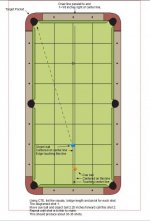Word salad.I'm not sure I know the correct terminology or have the knowledge to explain why the same perception can pocket shots from multiple positions like the 5 shots that seem to be such a controversial topic. I personally have done the 5 shots on 2 different diamond 9' tables, an 8' olhausen and valley and diamond bar boxes with the exact same results. I have yet to set up a curtain and attempt them blind but I'm quite sure the results would be the same.
If you are looking for some tidbit of acknowledgement that it may not be completely objective then I'm not sure what to tell you. In my opinion I think that there may be something going on subconsciously that causes one to adjust their visual perception ever so slightly as you reach the limits of each perception. I couldn't even begin to guess what that might be but it could be a limited explanation for the question you seem to be asking.
I honestly believe that a visual specialist and mathematician would have to spend quite a bit of time working with Stan to be able to come up with a mathematical explanation but I have no doubt that given a lot of time and money it could be done.
As far as the difference between perceptions goes I think there is plenty of information out there already that there is no need for me to explain them further. Determining the proper perception for each shot just comes with practice. I have yet to incorporate CTe/Pro 1 into my game 100% because I am not using the 45 and 60 perceptions consistently as of yet but I will be soon. I am currently using the 15 and 30 and pocketing balls at an extremely high rate.
...but glad it works for you.
pj
chgo
